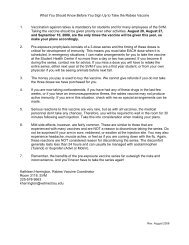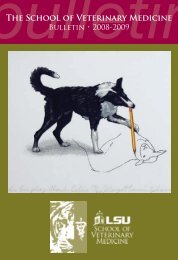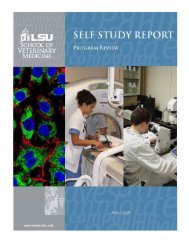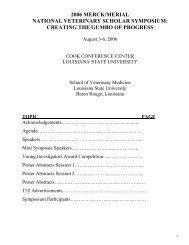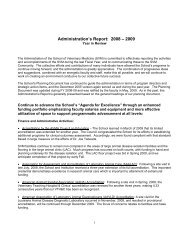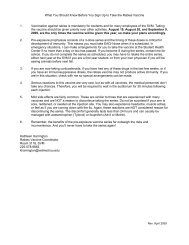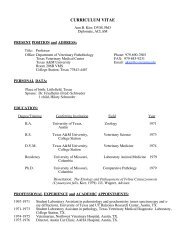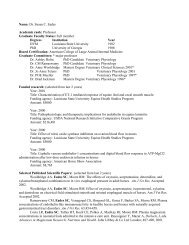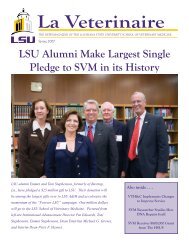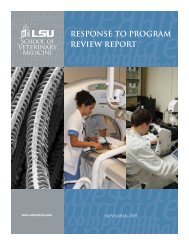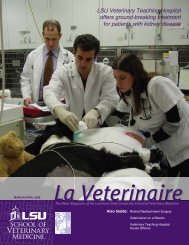in the Family - School of Veterinary Medicine - Louisiana State ...
in the Family - School of Veterinary Medicine - Louisiana State ...
in the Family - School of Veterinary Medicine - Louisiana State ...
You also want an ePaper? Increase the reach of your titles
YUMPU automatically turns print PDFs into web optimized ePapers that Google loves.
All <strong>in</strong> <strong>the</strong> <strong>Family</strong>: LSU <strong>School</strong> <strong>of</strong>Veter<strong>in</strong>ary Medic<strong>in</strong>e Celebrates LegaciesALUMNI ISSUEMAY/JUNE 2008Also Inside:Treat<strong>in</strong>g an ElandSav<strong>in</strong>g AlligatorsLSU SVM Class Agent Program
LETTER FROM THE ALUMNI & PUBLIC PROGRAMS COORDINATORhave a reception for <strong>the</strong> milestone reunion classes <strong>of</strong>1978, 1983, 1988, 1993, 1998, and 2003 at a localhotel with d<strong>in</strong>ner to follow. There will also be a jobfair <strong>the</strong> afternoon before <strong>the</strong> conference (October17). More <strong>in</strong>formation on all <strong>of</strong> this, as well as <strong>the</strong>conference agenda, will be available soon.It’s been a busy six months s<strong>in</strong>ce I moved fromDevelopment here at <strong>the</strong> <strong>School</strong> <strong>of</strong> Veter<strong>in</strong>ary Medic<strong>in</strong>e<strong>in</strong>to <strong>the</strong> Alumni and Public Programs position. I havevisited numerous cl<strong>in</strong>ics, talked with many <strong>of</strong> our alumnion <strong>the</strong> phone, and helped host alumni receptions fromOrlando to Las Vegas and cities <strong>in</strong> between. I’veenjoyed meet<strong>in</strong>g so many <strong>of</strong> our alumni and renew<strong>in</strong>gsome old friendships.The next few months will cont<strong>in</strong>ue to be busy as weplan more activities. Our next reception will be helddur<strong>in</strong>g <strong>the</strong> AVMA conference <strong>in</strong> New Orleans. We’ll bechang<strong>in</strong>g <strong>the</strong> venue on this one and go<strong>in</strong>g outside <strong>the</strong>hotel. The reception will take place at <strong>the</strong> Tropical Isle<strong>in</strong> <strong>the</strong> French Quarter. Please consider jo<strong>in</strong><strong>in</strong>g us <strong>the</strong>re<strong>the</strong> even<strong>in</strong>g <strong>of</strong> July 21 (from 6:30 p.m. until), whe<strong>the</strong>ryou’re go<strong>in</strong>g to <strong>the</strong> conference or not.The Alumni Reunions this year will be held dur<strong>in</strong>g <strong>the</strong><strong>School</strong> <strong>of</strong> Veter<strong>in</strong>ary Medic<strong>in</strong>e’s Annual Conferenceon October 18, but will be <strong>in</strong> a different format. We willWe wrapped up <strong>the</strong> Annual Campaign TelephoneAppeal at <strong>the</strong> end <strong>of</strong> April. It was a great success, withover $12,000 <strong>in</strong> donations pledged. Class agents willbe <strong>in</strong> touch with those alumni who did not receive atelephone call to discuss <strong>the</strong> campaign. There is alsomore <strong>in</strong>formation about <strong>the</strong> campaign on page 21 <strong>of</strong>this issue.There cont<strong>in</strong>ue to be terrific public programs like<strong>the</strong> Great Rover Road Run, Open House, and <strong>the</strong>International Exhibition on Animals <strong>in</strong> Art. We hopethat you can jo<strong>in</strong> us for <strong>the</strong>se events each year ifyou’re <strong>in</strong> <strong>the</strong> area. This was our 26th Annual OpenHouse (remember when it was your turn?) and <strong>the</strong> 21stAnimals <strong>in</strong> Art Exhibition. Both were great successes,with large numbers <strong>in</strong> attendance.It is an excit<strong>in</strong>g time to be <strong>in</strong> alumni affairs. We <strong>in</strong><strong>the</strong> Institutional Advancement Office are dedicatedto reconnect<strong>in</strong>g with our alumni. We want to rem<strong>in</strong>dyou <strong>of</strong> <strong>the</strong> good times, f<strong>in</strong>d out where our challengesare, and build a stronger allegiance. Your <strong>School</strong> willalways be here for you, and my door is always open.Gretchen MorganAlumni & Public Programs Coord<strong>in</strong>atorwww.vetmed.lsu.edu/svm_alumni_&_donors.htmLSU SCHOOL OF VETERINARY MEDICINE ADMINISTRATIONDr. Peter F. HaynesDeanDr. Thomas R. KleiAssociate Dean for Research and Advanced StudiesDr. Joseph TaboadaAssociate Dean for Student and Academic AffairsDr. David F. SeniorAssociate Dean for Advancement and Strategic InitiativesErnie TanoosAssistant Dean for F<strong>in</strong>ance and Adm<strong>in</strong>istrative Services<strong>School</strong> <strong>of</strong> Veter<strong>in</strong>ary Medic<strong>in</strong>e<strong>Louisiana</strong> <strong>State</strong> UniversityBaton Rouge, <strong>Louisiana</strong> 70803Adm<strong>in</strong>istration 225-578-9900Small Animal Cl<strong>in</strong>ic 225-578-9600Large Animal Cl<strong>in</strong>ic 225-578-9500www.vetmed.lsu.edu
ON THE COVERLSU <strong>School</strong> <strong>of</strong>Veter<strong>in</strong>ary Medic<strong>in</strong>eCelebrates LegaciesThe LSU SVM was founded <strong>in</strong> 1968 and acceptedits first students <strong>in</strong> 1973 for <strong>the</strong> Class <strong>of</strong> 1977. S<strong>in</strong>cethat first class, <strong>the</strong> SVM has graduated over 2,000veter<strong>in</strong>arians. Some <strong>of</strong> those veter<strong>in</strong>arians have a lot<strong>in</strong> common. Children <strong>of</strong> alumni are follow<strong>in</strong>g <strong>in</strong> <strong>the</strong>irparents footsteps, and <strong>the</strong>re are many o<strong>the</strong>r familyconnections as well. Full story on page 2.COVER PHOTO: Dr. Veronica Paul-Duncan (LSU 2005) [left] and hermo<strong>the</strong>r, Dr. Debbie P. Guillory (LSU 1983), attend <strong>the</strong> reception at <strong>the</strong>LSU <strong>School</strong> <strong>of</strong> Veter<strong>in</strong>ary Medic<strong>in</strong>e after commencement <strong>in</strong> May 2005.ABOVE: LSU graduate Dr. Neil Henderson (left) works <strong>in</strong> aveter<strong>in</strong>ary practice <strong>in</strong> Stonewall, La., with his fa<strong>the</strong>r, fellow LSUgraduate Dr. Robert Henderson (right).Page 4 Page 13Page 8TABLE OF CONTENTSAll <strong>in</strong> <strong>the</strong> <strong>Family</strong>....................................................................... 2Alligator Research................................................................. 4New Faculty................................................................................ 7Treat<strong>in</strong>g an Eland................................................................... 8A Moment <strong>in</strong> History ..........................................................10Look<strong>in</strong>g Back at <strong>the</strong> SVM..................................................12SVM Events.................................................................................13Alumni Pr<strong>of</strong>ile.........................................................................14Alumni Tracks and Baby Vets.........................................16Class Agent Program..........................................................18Mobile Emergency Response Unit................................20New Books Benefit <strong>the</strong> LSU SVM...................................22Support<strong>in</strong>g <strong>the</strong> LSu SVM & Forever LSU...................23G<strong>in</strong>ger GuttnerEditorKathleen Harr<strong>in</strong>gtonWriter and WebmasterLa Veter<strong>in</strong>aire is published by <strong>the</strong> <strong>Louisiana</strong> <strong>State</strong> University,<strong>School</strong> <strong>of</strong> Veter<strong>in</strong>ary Medic<strong>in</strong>e, Office <strong>of</strong> Public Relations.Communications should be addressed to Editor, La Veter<strong>in</strong>aire,<strong>School</strong> <strong>of</strong> Veter<strong>in</strong>ary Medic<strong>in</strong>e, <strong>Louisiana</strong> <strong>State</strong> University, BatonRouge, LA 70803, or sent via e-mail to gguttner@vetmed.lsu.edu.
All <strong>in</strong> <strong>the</strong> <strong>Family</strong>Dr. Robert Henderson (LSU 1977)In 1973, Robert Henderson was accepted <strong>in</strong>to <strong>the</strong> LSU<strong>School</strong> <strong>of</strong> Veter<strong>in</strong>ary Medic<strong>in</strong>e’s first class. He started hisveter<strong>in</strong>ary education <strong>in</strong> January 1974. Seventeen years later,his son, Neil Henderson started classes at <strong>the</strong> LSU SVM.“I had to fulfill admission requirements for veter<strong>in</strong>ary schools<strong>in</strong> Oklahoma, Texas and Auburn because we didn’t knowif <strong>the</strong> LSU school was go<strong>in</strong>g to start,” said Dr. RobertHenderson. “I went so far as to talk to Auburn, and I visitedover <strong>the</strong>re, but <strong>the</strong>y ended up send<strong>in</strong>g my application backbecause LSU started <strong>the</strong>ir program.”“Be<strong>in</strong>g <strong>the</strong> first class, we got lots <strong>of</strong> hands-on experienceand received a very well-rounded education,” cont<strong>in</strong>uedRobert, who worked with Dr. Sam Monticello, a large animalpractitioner <strong>in</strong> Lake Charles, La., for three years aftergraduation. However, be<strong>in</strong>g from north <strong>Louisiana</strong>, he wantedto return <strong>the</strong>re and did so <strong>in</strong> 1980, work<strong>in</strong>g for two o<strong>the</strong>r largeanimal practitioners. In 1984, Robert opened his own practice<strong>in</strong> Stonewall, La., located eight miles south <strong>of</strong> Shreveport.While <strong>the</strong> practice was a majority equ<strong>in</strong>e practice at that time,it is now primarily a small animal practice.“I did not encourage Neil to become a veter<strong>in</strong>arian because<strong>of</strong> <strong>the</strong> economics <strong>of</strong> <strong>the</strong> pr<strong>of</strong>ession and because <strong>the</strong> amount<strong>of</strong> time on-call is difficult,” said Robert. “He sometimes wentwith me on calls and watched me lay on my stomach for twoor three hours <strong>in</strong> <strong>the</strong> middle <strong>of</strong> <strong>the</strong> night, so he knew it washard. I also wanted him to know about <strong>the</strong> bus<strong>in</strong>ess side <strong>of</strong>veter<strong>in</strong>ary medic<strong>in</strong>e.”“It’s important for veter<strong>in</strong>ary students to focus at leastsome on operat<strong>in</strong>g a bus<strong>in</strong>ess,” adds Robert. “Veter<strong>in</strong>arypr<strong>of</strong>essional knowledge and experience is good, but it’s notenough. I wanted him to understand that this can be a toughpr<strong>of</strong>ession, but when he decided, I was tickled to death.”Dr. Neil Henderson (LSU 1995)Dr. Neil Henderson was seven years old when his fa<strong>the</strong>rgraduated from that first veter<strong>in</strong>ary school class. “I havebeen surrounded by veter<strong>in</strong>ary medic<strong>in</strong>e all <strong>of</strong> my life and2
absolutely love it,” said Neil. “After high school I followed <strong>in</strong>my dad’s footsteps and attended <strong>Louisiana</strong> Tech for threeyears and <strong>the</strong>n was accepted <strong>in</strong>to <strong>the</strong> LSU SVM <strong>in</strong> 1991. Iwas <strong>the</strong> first son <strong>of</strong> an alumnus to graduate from <strong>the</strong> schoolwhen I f<strong>in</strong>ished <strong>in</strong> 1995.”Like his fa<strong>the</strong>r, Neil worked with Dr. Sam Monticello <strong>in</strong> LakeCharles when he did a preceptorship at this practice <strong>in</strong> <strong>the</strong>spr<strong>in</strong>g <strong>of</strong> 1995. “Dur<strong>in</strong>g that six-week period, we had more<strong>in</strong>terest<strong>in</strong>g cases than I could have dreamed <strong>of</strong>,” said Neil.“It was pretty neat to work and learn from someone that mydad had worked for. I also did a preceptorship with Drs. SteveEverson and Milton Williams <strong>in</strong> <strong>the</strong> fall <strong>of</strong> 1994, and <strong>the</strong>y couldnot have been more helpful to me.”After graduat<strong>in</strong>g from <strong>the</strong> LSU SVM, Neil jo<strong>in</strong>ed his fa<strong>the</strong>r <strong>in</strong>his mixed animal practice <strong>in</strong> Stonewall. “By be<strong>in</strong>g a graduate<strong>of</strong> <strong>the</strong> LSU SVM, I was very prepared for <strong>the</strong> challengesthat awaited me when I graduated,” said Neil. “The learn<strong>in</strong>gprocess is cont<strong>in</strong>uous and that is a very fun part <strong>of</strong> it forme. The veter<strong>in</strong>ary community is a very close knit family,and <strong>the</strong>re is always someone will<strong>in</strong>g to lend a help<strong>in</strong>g hand.One person that has gone out <strong>of</strong> his way to challengeand teach me is Dr. Greg Gill. He has never hesitatedwhen I have asked him for advice or asked to learn a newprocedure. Fortunately, veter<strong>in</strong>arians are like that. We arealways <strong>in</strong>terested <strong>in</strong> teach<strong>in</strong>g o<strong>the</strong>rs and reach<strong>in</strong>g out to ourcommunity to benefit <strong>the</strong>m and <strong>the</strong>ir pets.”The o<strong>the</strong>r person that <strong>in</strong>fluenced Neil was his fa<strong>the</strong>r. “I startedrid<strong>in</strong>g with him on farm calls when I was 10 or 11,” said Neil.“I took <strong>the</strong> good with <strong>the</strong> bad, and that means I was <strong>the</strong> onewho went with him to help pull a calf at night or work on acolic on a Sunday afternoon. I learned very early how toproperly clean a cage and a stall and help keep <strong>the</strong> grasscut at <strong>the</strong> <strong>of</strong>fice. I learned how gratify<strong>in</strong>g it can be to help aperson with a beloved pet that is <strong>in</strong> trouble. Dad knew thatit was important for me to see all <strong>of</strong> <strong>the</strong> different aspects <strong>of</strong>veter<strong>in</strong>ary medic<strong>in</strong>e before I embarked on this career path.He never encouraged me nor discouraged me to pursueveter<strong>in</strong>ary medic<strong>in</strong>e as my career; he merely laid a strongfoundation for me to be successful <strong>in</strong> whatever career thatI was go<strong>in</strong>g to choose. We still learn from each o<strong>the</strong>r everyday, and we both take a great deal <strong>of</strong> pride <strong>in</strong> graduat<strong>in</strong>g from<strong>the</strong> LSU SVM.”Dr. Debbie Guillory (LSU 1983)In 1979, Dr. Debbie Paul (now Dr. Debbie Paul Guillory)started veter<strong>in</strong>ary school at LSU. “I was never go<strong>in</strong>g to doanyth<strong>in</strong>g else,” said Debbie. “As soon as I knew what ananimal was, it’s all I wanted to be.”After graduat<strong>in</strong>g <strong>in</strong> 1983, Debbie returned home to Vidalia,La., and opened her own practice. Her daughter Veronicawas four years old at <strong>the</strong> time (she was n<strong>in</strong>e months old whenDebbie started veter<strong>in</strong>ary school). “Dr. Penny Serio was aclassmate <strong>of</strong> m<strong>in</strong>e, and she and I took turns tak<strong>in</strong>g care <strong>of</strong>Veronica,” said Debbie. “My second daughter L<strong>in</strong>dsey wasborn <strong>in</strong> May 1983, <strong>the</strong> year I graduated.” Debbie has fourchildren, and three <strong>of</strong> <strong>the</strong>m are <strong>in</strong>volved <strong>in</strong> medical fields.Debbie had that first cl<strong>in</strong>ic for about 12 years before shepurchased some land and opened her current cl<strong>in</strong>ic <strong>in</strong> Vidalia.After graduat<strong>in</strong>g <strong>in</strong> 2005, her daughter Veronica jo<strong>in</strong>ed <strong>the</strong>practice. “It’s a lot <strong>of</strong> fun work<strong>in</strong>g toge<strong>the</strong>r,” said Debbie. “It’ssometimes hard for us to do th<strong>in</strong>gs toge<strong>the</strong>r outside <strong>of</strong> <strong>the</strong>practice because <strong>of</strong> emergency calls. At work we complementeach o<strong>the</strong>r, s<strong>in</strong>ce I’m a little old school, and she’s new school.I didn’t push her to go <strong>in</strong>to veter<strong>in</strong>ary medic<strong>in</strong>e; she made <strong>the</strong>decision on her own.”All <strong>in</strong> <strong>the</strong> <strong>Family</strong> cont<strong>in</strong>ued on page 6LEFT: Senior composite photographs(from left to right) <strong>of</strong> Drs. RobertHenderson, Debbie Guillory, NeilHenderson, and Veronica Paul-Duncan.ABOVE LEFT: Dr. Neil Henderson(left) from <strong>the</strong> LSU <strong>School</strong> <strong>of</strong> Veter<strong>in</strong>aryMedic<strong>in</strong>e Class <strong>of</strong> 1995 works <strong>in</strong> amixed animal practice <strong>in</strong> Stonewall, La.,with his fa<strong>the</strong>r, Dr. Robert Henderson(right) from <strong>the</strong> Class <strong>of</strong> 1977.3
ResearchABOVE: Venipuncture from <strong>the</strong> ventral coccygeal ve<strong>in</strong> <strong>in</strong> an alligator.RIGHT: Dr. Javier Nevarez (left) works with personnel from <strong>the</strong> LA Department <strong>of</strong> Wildlife andFisheries on an alligator farm.LSU Veter<strong>in</strong>arian’s Work Benefits AlligatorIndustry <strong>in</strong> <strong>Louisiana</strong>Even after cutt<strong>in</strong>g massive losses to <strong>the</strong> $50 million<strong>Louisiana</strong> alligator <strong>in</strong>dustry by discover<strong>in</strong>g that West NileVirus was <strong>the</strong> cause <strong>of</strong> holes develop<strong>in</strong>g <strong>in</strong> <strong>the</strong>ir sk<strong>in</strong>s (thusseverely reduc<strong>in</strong>g <strong>the</strong>ir value), Dr. Javier Nevarez is stillvery <strong>in</strong>volved <strong>in</strong> alligator agriculture. Dr. Nevarez, assistantpr<strong>of</strong>essor <strong>of</strong> zoological medic<strong>in</strong>e, is a specialist <strong>in</strong> <strong>the</strong> field<strong>of</strong> alligator health. Under research grants from <strong>the</strong> Alligatorand Fur Council <strong>of</strong> <strong>the</strong> <strong>Louisiana</strong> Department <strong>of</strong> Wildlife andFisheries (LDWF) and from <strong>the</strong> USDA’s Animal and PlantHealth Inspection Service, Dr. Nevarez is work<strong>in</strong>g to improve<strong>the</strong> health <strong>of</strong> <strong>Louisiana</strong>’s alligators and provide support for<strong>Louisiana</strong>’s alligator <strong>in</strong>dustry.The LDWF manages <strong>the</strong> American alligator (Alligatormississippiensis) as a commercial, renewable naturalresource for <strong>the</strong> state. The Department’s alligator programties <strong>the</strong> management and conservation <strong>of</strong> <strong>the</strong> state’s alligatorsto ma<strong>in</strong>ta<strong>in</strong><strong>in</strong>g <strong>Louisiana</strong>’s wetland ecosystem. This providesbenefits not only to <strong>the</strong> species, but to its habitat and <strong>the</strong> o<strong>the</strong>rspecies <strong>of</strong> fish and wildlife associated with alligators.One <strong>of</strong> Dr. Nevarez’s projects is focused on <strong>the</strong>pharmacok<strong>in</strong>etics <strong>of</strong> tetracycl<strong>in</strong>e for treatment <strong>of</strong> bacterialpneumonia <strong>of</strong> alligators. By determ<strong>in</strong><strong>in</strong>g <strong>the</strong> distributionand concentration <strong>in</strong> <strong>the</strong> tissues <strong>of</strong> animal’s body afteradm<strong>in</strong>istration <strong>of</strong> <strong>the</strong> drug, Dr. Nevarez expects to be able toestablish <strong>the</strong> most efficacious dosage protocols, which willenable alligator farmers to make sure <strong>the</strong> treatment regimens<strong>the</strong>y adm<strong>in</strong>ister are both effective and cost-efficient.Because alligator meat is <strong>in</strong>tended for human consumption,it cannot be sold if drug residues are higher than a level4
set by law, so it is necessary to withhold treatment for acerta<strong>in</strong> period <strong>of</strong> time before slaughter. “Our research willhelp determ<strong>in</strong>e <strong>the</strong> clearance rate <strong>of</strong> tetracycl<strong>in</strong>e afteradm<strong>in</strong>istration to farmed alligators, so that <strong>the</strong> necessarywithdrawal time can be established,” said Dr. Nevarez.Some <strong>of</strong> <strong>the</strong> farmed alligators are released to <strong>the</strong> wild eachyear, which is ano<strong>the</strong>r area <strong>of</strong> concern for Dr. Nevarez. One<strong>of</strong> his major <strong>in</strong>terests is evaluat<strong>in</strong>g how diseases <strong>of</strong> captivealligators can affect wild populations, so he conducts healthsurveillance surveys <strong>of</strong> those farmed animals that are to bereleased.Alligators are released each year from March through August,and this summer marks <strong>the</strong> second year <strong>of</strong> <strong>the</strong> on-go<strong>in</strong>ghealth surveillance study. “We look at a subset <strong>of</strong> <strong>the</strong> gatorsthat will be released,” he said, “and do various tests on <strong>the</strong>mto determ<strong>in</strong>e <strong>the</strong>ir health status.”In 2007, a hundred alligators (20 each randomly selectedfrom five different farms) were brought to <strong>the</strong> LSU <strong>School</strong> <strong>of</strong>Veter<strong>in</strong>ary Medic<strong>in</strong>e for a full cl<strong>in</strong>ical evaluation and necropsy.This year, Dr. Nevarez plans to expand <strong>the</strong> test group to150. In addition to be<strong>in</strong>g screened for West Nile virus andMycoplasma alligatoris, a bacterium that causes an acutelethal cardiopulmonary <strong>in</strong>fection <strong>in</strong> alligators, <strong>the</strong> test subsetsare exam<strong>in</strong>ed grossly for any obvious signs <strong>of</strong> disease, andsamples <strong>of</strong> blood, lung, liver, and feces are collected foranalysis. These will be cultured for bacteria, exam<strong>in</strong>ed byelectron microscopy for viruses, and evaluated for parasites.“We want to make sure <strong>the</strong>se alligators not only are healthyon <strong>the</strong> farms, but that <strong>the</strong>y do not <strong>in</strong>troduce diseases back<strong>in</strong>to <strong>the</strong> wild,” said Dr. Nevarez.The <strong>Louisiana</strong> Department <strong>of</strong> Wildlife and Fisheries alsosponsors cl<strong>in</strong>ical consultation services for <strong>the</strong> alligatorfarmers. Farmers who notice any unusual behavior or signs <strong>of</strong>illness among <strong>the</strong>ir alligators can consult with Dr. Nevarez fordiagnostic test<strong>in</strong>g and advice.Dr. Nevarez received his DVM and his PhD from <strong>the</strong> LSU<strong>School</strong> <strong>of</strong> Veter<strong>in</strong>ary Medic<strong>in</strong>e <strong>in</strong> 2001 and 2007, respectively.He is currently an assistant pr<strong>of</strong>essor <strong>of</strong> zoological medic<strong>in</strong>e<strong>in</strong> <strong>the</strong> Department <strong>of</strong> Veter<strong>in</strong>ary Cl<strong>in</strong>ical Sciences.5
All <strong>in</strong> <strong>the</strong> <strong>Family</strong> (cont<strong>in</strong>ued)Dr. Veronica Paul-Duncan (LSU 2005)Dr. Veronica Paul-Duncan started veter<strong>in</strong>ary school at LSU <strong>in</strong>2001 and graduated <strong>in</strong> 2005. “I’ve grown up <strong>in</strong> it [veter<strong>in</strong>arymedic<strong>in</strong>e],” said Veronica. “I don’t ever remember not be<strong>in</strong>gat <strong>the</strong> cl<strong>in</strong>ic or not be<strong>in</strong>g a part <strong>of</strong> this. It’s someth<strong>in</strong>g I cando where I can have <strong>the</strong> best <strong>of</strong> both worlds and work withpeople and animals. I’ve seen some pretty remarkablerelationships between people and <strong>the</strong>ir animals, and it’s anhonor to have someone trust you with <strong>the</strong>ir animal.”Like Robert, Debbie did not push her child to go <strong>in</strong>toveter<strong>in</strong>ary medic<strong>in</strong>e. Veronica recalled a long conversationshe had with Dr. Dennis French, pr<strong>of</strong>essor <strong>of</strong> veter<strong>in</strong>aryscience and pr<strong>of</strong>essor <strong>of</strong> food animal medic<strong>in</strong>e and surgery.“I wanted to make sure that I was do<strong>in</strong>g this because this waswhat I truly wanted to do and not just because it was familiar,”said Veronica. “I would have to say if anyone helped me todecide that this was what I wanted to do, it was Dr. French.”“If I had to give veter<strong>in</strong>ary students any advice, it would beto remember that you went through a lot to earn your seatand you’re go<strong>in</strong>g to go through a lot to keep your seat,” saidVeronica. “There were days when I was <strong>in</strong> school that I justdidn’t see <strong>the</strong> po<strong>in</strong>t <strong>of</strong> what we were be<strong>in</strong>g taught, but <strong>in</strong> <strong>the</strong>end, it all teaches you patience and how to persevere. One <strong>of</strong><strong>the</strong> neatest people that helped me <strong>the</strong> most was Gaye Gomila<strong>in</strong> <strong>the</strong> Student Affairs Office. If you were stressed out, youcould just put your head on her desk, and she’d reach across<strong>the</strong> desk, pat your head, and tell you it would be okay.”“I’m glad that I attended LSU,” adds Veronica. “Dean[Michael] Groves was a very personable dean, and Dr.[Peter] Haynes was always available. I had a lot <strong>of</strong> clientcommunication as a student, and that makes a big difference.You were pushed to learn how to articulate a conversationand how to expla<strong>in</strong> th<strong>in</strong>gs to clients.”After graduation, Veronica immediately embarked on herveter<strong>in</strong>ary career at her mo<strong>the</strong>r’s practice. “I graduated onMonday and picked up my license to practice on Tuesday,”said Veronica. “I was <strong>the</strong>re when <strong>the</strong>y opened <strong>the</strong> <strong>of</strong>fice andasked <strong>the</strong>m to pr<strong>in</strong>t my license. My first appo<strong>in</strong>tment was at1:00 p.m. on Wednesday.”Veronica recently lost over 160 pounds and had her first child,Tenny Joseph Duncan, on April 1, 2008. She is <strong>the</strong> LSU SVMclass agent for <strong>the</strong> Class <strong>of</strong> 2005 and is still work<strong>in</strong>g at <strong>the</strong>same practice as her mo<strong>the</strong>r. Now she br<strong>in</strong>gs her son to workwith her. Debbie adds, “If you pick a job a love, <strong>the</strong>n younever work a day <strong>in</strong> your life.”With <strong>the</strong> Commencement Ceremony for <strong>the</strong> Class <strong>of</strong> 2008on May 12, <strong>the</strong> LSU SVM has graduated 2,257 veter<strong>in</strong>arians.Of those, several have family connections to <strong>the</strong> LSU SVM,<strong>in</strong>clud<strong>in</strong>g parents and children, sibl<strong>in</strong>gs, aunts and uncles,cous<strong>in</strong>s, and spouses. “We consider all <strong>of</strong>our graduates to be a part <strong>of</strong> <strong>the</strong> LSU SVMfamily,” said Gretchen Morgan, alumni & publicprograms coord<strong>in</strong>ator. “We look forward tosee<strong>in</strong>g more and more relatives <strong>of</strong> our alumnichoose veter<strong>in</strong>ary medic<strong>in</strong>e as <strong>the</strong>ir pr<strong>of</strong>ession.”For <strong>in</strong>formation on alumni activities andresources, please go to www.vetmed.lsu.edu/svm_alumni_&_donors.htm.LEFT: Dr. Debbie Guillory (left) from <strong>the</strong> LSU<strong>School</strong> <strong>of</strong> Veter<strong>in</strong>ary Medic<strong>in</strong>e Class <strong>of</strong> 1983congratulates her daughter Veronica Paul-Duncan after she receives her white coat at<strong>the</strong> Coat<strong>in</strong>g Ceremony for <strong>the</strong> Class <strong>of</strong> 2005.6
Cl<strong>in</strong>ical Case StudyTreat<strong>in</strong>g an Eland Presents UniqueChallenges for LSU Veter<strong>in</strong>ary <strong>School</strong>Treated by Drs. Gary A. Sod (LSU 2001), assistant pr<strong>of</strong>essor <strong>of</strong> Farm Animal Health; Patricia Queiroz, assistant pr<strong>of</strong>essor <strong>of</strong> veter<strong>in</strong>ary anes<strong>the</strong>siology; TimmGudehus, equ<strong>in</strong>e surgery resident; Luis Santos, anes<strong>the</strong>siology <strong>in</strong>tern; and Andrew Lewis, equ<strong>in</strong>e surgery <strong>in</strong>tern.In February, <strong>the</strong> LSU <strong>School</strong> <strong>of</strong> Veter<strong>in</strong>ary Medic<strong>in</strong>e treatedFernando, a seven-year-old eland from <strong>the</strong> Hattiesburg Zoo <strong>in</strong>Hattiesburg, Miss. The eland had been kicked <strong>in</strong> <strong>the</strong> face bya zebra and had an open displaced mandibular fracture.ketam<strong>in</strong>e. There was no way to know how <strong>the</strong> animal wouldrespond to <strong>the</strong> anes<strong>the</strong>sia, and John Wright, general curatorfor <strong>the</strong> Hattiesburg Zoo, is writ<strong>in</strong>g a paper on this particularcase.The eland was difficult to approach. Us<strong>in</strong>g a pole syr<strong>in</strong>gethrough <strong>the</strong> trailer, <strong>the</strong> eland was given 40 cc <strong>of</strong> ketam<strong>in</strong>eIM. Adult horses usually receive 10 cc <strong>in</strong>travenously prior tosurgery. The eland had already received 30 cc <strong>of</strong> ketam<strong>in</strong>eprior to be<strong>in</strong>g loaded <strong>in</strong>to <strong>the</strong> trailer and com<strong>in</strong>g to LSU.Once he was sedated, <strong>the</strong> anes<strong>the</strong>siologist was able to <strong>in</strong>sertan IV <strong>in</strong> a ve<strong>in</strong> beh<strong>in</strong>d <strong>the</strong> ear and <strong>in</strong>fused ano<strong>the</strong>r 20 cc <strong>of</strong>It took 10 people to move <strong>the</strong> eland from <strong>the</strong> trailer, onto acart and <strong>in</strong>to <strong>the</strong> surgery recovery stall, which is a paddedstall next to <strong>the</strong> surgery suite with a moveable floor used totransport large animals from <strong>the</strong> barn <strong>in</strong>to surgery. The elandwas moved from <strong>the</strong> stall <strong>in</strong>to <strong>the</strong> surgery suite and onto <strong>the</strong>surgery table.8
For <strong>the</strong> next two years, university adm<strong>in</strong>istrators met with aSREB Committee that was attempt<strong>in</strong>g to determ<strong>in</strong>e <strong>the</strong> needand <strong>the</strong> tra<strong>in</strong><strong>in</strong>g capacity for regional students <strong>in</strong> veter<strong>in</strong>arymedic<strong>in</strong>e. In May 1972, <strong>the</strong> director <strong>of</strong> <strong>the</strong> SREB requestedterm<strong>in</strong>ation <strong>of</strong> <strong>the</strong> <strong>Louisiana</strong> contract. In October 1972, <strong>the</strong>SREB notified President Wood<strong>in</strong> <strong>of</strong> <strong>the</strong> unilateral cancellation<strong>of</strong> <strong>the</strong> SREB/LA contract beg<strong>in</strong>n<strong>in</strong>g <strong>in</strong> <strong>the</strong> fall <strong>of</strong> 1973. Theaction was <strong>in</strong>itiated by <strong>the</strong> Texas A&M University College<strong>of</strong> Veter<strong>in</strong>ary Medic<strong>in</strong>e. The purpose <strong>of</strong> this action was topressure LSU to announce <strong>the</strong> program start date. On May 7,1973, LSU announced that <strong>in</strong>struction <strong>in</strong> veter<strong>in</strong>ary medic<strong>in</strong>ewould beg<strong>in</strong> on January 4, 1974, with <strong>the</strong> application periodto beg<strong>in</strong> on May 18. All <strong>Louisiana</strong> applications to regionalschools were returned to LSU.Admissions Committee decisionswere announced on August 17,1973. One hundred and twenty sixapplications were received, and 36candidates (30 male and six female),all from <strong>Louisiana</strong>, were admitted to<strong>the</strong> first class <strong>of</strong> <strong>the</strong> LSU <strong>School</strong> <strong>of</strong>Veter<strong>in</strong>ary Medic<strong>in</strong>e. The <strong>Louisiana</strong>/SREB tra<strong>in</strong><strong>in</strong>g spaces for veter<strong>in</strong>arymedic<strong>in</strong>e were released, and <strong>the</strong>University requested assignment <strong>of</strong>tra<strong>in</strong><strong>in</strong>g spaces at LSU for <strong>the</strong> fall <strong>of</strong> 1974.A comparative summary for graduates dur<strong>in</strong>g <strong>the</strong> first 13years <strong>of</strong> <strong>in</strong>struction (1977-1989) is available. Similar datafor <strong>the</strong> rema<strong>in</strong><strong>in</strong>g years have not been compiled. The totalnumber <strong>of</strong> graduates dur<strong>in</strong>g <strong>the</strong> period was 885 (92.6% <strong>of</strong>those enrolled). Of <strong>the</strong>se, 245 (28%) were from out <strong>of</strong> state:Arkansas (194), West Virg<strong>in</strong>ia (36), Mississippi (8), andPuerto Rico (7).Two hundred and fifty-two applications were received for <strong>the</strong>second class, and 48 candidates (32 male and 16 female)were admitted. Of <strong>the</strong>se, 36 were from <strong>Louisiana</strong>, six werefrom Arkansas, three were from Mississippi, and three werefrom West Virg<strong>in</strong>ia. The fourth enter<strong>in</strong>g class was <strong>the</strong> firstwith 80 candidates. Of <strong>the</strong>se, 56 were from <strong>Louisiana</strong>, 15were from Arkansas, five were from Mississippi, and four werefrom West Virg<strong>in</strong>ia. As <strong>the</strong> program advanced, <strong>the</strong> numberOne hundred and twenty sixapplications were received,and 36 candidates (30 maleand six female), all from<strong>Louisiana</strong>, were admittedto <strong>the</strong> first class <strong>of</strong> <strong>the</strong> LSU<strong>School</strong> <strong>of</strong> Veter<strong>in</strong>ary Medic<strong>in</strong>e.<strong>of</strong> regional students per enter<strong>in</strong>g class varied, as did <strong>the</strong>participat<strong>in</strong>g states, with <strong>the</strong> exception <strong>of</strong> Arkansas.Over <strong>the</strong> years, <strong>the</strong> protocol for determ<strong>in</strong><strong>in</strong>g eligibility <strong>of</strong> out<strong>of</strong>-stateapplicants has changed. The make-up <strong>of</strong> <strong>the</strong> Class<strong>of</strong> 2008 upon admission to <strong>the</strong> LSU <strong>School</strong> <strong>of</strong> Veter<strong>in</strong>aryMedic<strong>in</strong>e is an <strong>in</strong>dication <strong>of</strong> how diverse class membershiphas become. Of <strong>the</strong> 83 candidates admitted <strong>in</strong> <strong>the</strong> fall <strong>of</strong>2005, 54 were from <strong>Louisiana</strong>; n<strong>in</strong>e were from Arkansas; foureach were from New York and Puerto Rico; two each werefrom Florida, Maryland, Michigan, and Pennsylvania; andone each were from Ill<strong>in</strong>ois, Massachusetts, New Jersey, andTexas.List<strong>in</strong>gs <strong>of</strong> veter<strong>in</strong>arians by states isavailable through <strong>the</strong> various stateassociation directories, but <strong>the</strong>se donot give a true <strong>in</strong>dication <strong>of</strong> <strong>in</strong>stitutionalalumni practic<strong>in</strong>g with<strong>in</strong> a particularstate. Association members arelisted with personal details, <strong>in</strong>clud<strong>in</strong>g<strong>the</strong> <strong>in</strong>stitution that awarded <strong>the</strong>DVM degree by year. Non-memberveter<strong>in</strong>arians are not listed; however,<strong>the</strong> total number is usually noted. Forexample, <strong>the</strong> 2008 American Veter<strong>in</strong>ary Medical AssociationDirectory lists 615 veter<strong>in</strong>arians as members practic<strong>in</strong>g <strong>in</strong>Arkansas. Of <strong>the</strong>se, at least 195 (32%) are LSU graduates.However, <strong>the</strong>re are 150 non-members practic<strong>in</strong>g <strong>in</strong> Arkansasfor which <strong>the</strong>re is no personal <strong>in</strong>formation.<strong>Louisiana</strong> has <strong>the</strong> highest number <strong>of</strong> LSU alumni practic<strong>in</strong>gwith<strong>in</strong> <strong>the</strong> state. The AVMA lists <strong>the</strong> number <strong>of</strong> memberveter<strong>in</strong>arians for <strong>Louisiana</strong> as 1,004, with at least 595 LSUgraduates (over 59%). Additionally, 185 non-memberveter<strong>in</strong>arians are listed for which <strong>the</strong>re is no personal<strong>in</strong>formation.LSU alumni have been located practic<strong>in</strong>g veter<strong>in</strong>ary medic<strong>in</strong>e<strong>in</strong> all SREB contract states and Puerto Rico.11
SVM EventsSue Loubiere, librarian emerita, was recognized for her 19 years <strong>of</strong> service to<strong>the</strong> International Animals <strong>in</strong> Art Exhibition. Former and current deans attend<strong>in</strong>g<strong>the</strong> event are Dean Emeritus Michael G. Groves (dean from (2000-2006), DeanEmeritus William L. Jenk<strong>in</strong>s (1988-1993), Sue Loubiere, Dr. David L. Huxsoll(1995-1999), and Dean Peter F. Haynes (2007-present).Two hundred and sixty-one people participated <strong>in</strong> <strong>the</strong> Hill’s 15th AnnualGreat Rover Road Run on March 29 at <strong>the</strong> LSU <strong>School</strong> <strong>of</strong> Veter<strong>in</strong>aryMedic<strong>in</strong>e. One hundred and n<strong>in</strong>ety people participated <strong>in</strong> <strong>the</strong> one mile funrun/walk, and one hundred and six people ran <strong>in</strong> <strong>the</strong> 5K. Once aga<strong>in</strong>, thisyear’s major sponsor was Hill’s Pet Nutrition.The LSU <strong>School</strong> <strong>of</strong> Veter<strong>in</strong>ary Medic<strong>in</strong>e opened its 21stInternational Exhibition on Animals <strong>in</strong> Art on March 29. Morethan 200 guests attended <strong>the</strong> open<strong>in</strong>g reception. The exhibitionclosed on April 27 but can be viewed on-l<strong>in</strong>e at www.vetmed.lsu.edu. The Dog’s Chair (left), an acrylic by Albuquerque,N.M., artist Marjie Bassler, received an SVM Award and will befeatured on <strong>the</strong> 2009 International Exhibition on Animals <strong>in</strong> ArtShow program.Select third- and fourth-year veter<strong>in</strong>ary students,graduate students, residents and <strong>in</strong>terns, and facultywere <strong>in</strong>ducted <strong>in</strong>to <strong>the</strong> Tau Chapter <strong>of</strong> Phi Zeta on April24. Phi Zeta is a national Veter<strong>in</strong>ary Honor Society, <strong>the</strong>object <strong>of</strong> which is to recognize and promote scholarshipand research <strong>in</strong> matters perta<strong>in</strong><strong>in</strong>g to <strong>the</strong> welfare anddiseases <strong>of</strong> animals. The Tau Chapter <strong>of</strong> Phi Zeta was<strong>in</strong>stalled on March 30, 1977, with Dr. C.W. Titkemeyeras Chapter President. Phi Zeta is <strong>the</strong> abbreviation<strong>of</strong> <strong>the</strong> Greek word Philozoi, which means “love <strong>of</strong>animals.”13
Alumni Pr<strong>of</strong>ile1988 Alumnus Dr. Mark MikelonisWhat made you want to be a veter<strong>in</strong>arian?While grow<strong>in</strong>g up I always had a love <strong>of</strong> animals, and <strong>in</strong> mylate teens had given serious thought to pursu<strong>in</strong>g a career<strong>in</strong> human medic<strong>in</strong>e. The decision was made for me while Iwas work<strong>in</strong>g with veter<strong>in</strong>arians after high school. We workedon different species and <strong>in</strong> various areas from orthopedics,to <strong>in</strong>ternal medic<strong>in</strong>e, to dentistry, to dermatology and soon. As I learned more about <strong>the</strong> pr<strong>of</strong>ession, I rememberbe<strong>in</strong>g totally <strong>in</strong>trigued by <strong>the</strong> multifaceted role a veter<strong>in</strong>arianplayed <strong>in</strong> many fields. I knew <strong>the</strong>n, that I wanted that k<strong>in</strong>d <strong>of</strong>challeng<strong>in</strong>g career for my future.What was LSU SVM like when you attended?One expression: “ fire hose.” We were quickly assimilated<strong>in</strong>to <strong>in</strong>formation process<strong>in</strong>g mach<strong>in</strong>es, and I thought it wasgreat! You learn early on that veter<strong>in</strong>ary school really is just<strong>the</strong> beg<strong>in</strong>n<strong>in</strong>g <strong>of</strong> <strong>the</strong> learn<strong>in</strong>g process and cont<strong>in</strong>ues on everyday <strong>in</strong> practice. Shar<strong>in</strong>g <strong>the</strong> <strong>in</strong>tensity and completion <strong>of</strong> aveter<strong>in</strong>ary curriculum with your classmates creates memoriesand bonds that last a lifetime.How did <strong>the</strong> LSU SVM prepare you for your career<strong>in</strong> veter<strong>in</strong>ary medic<strong>in</strong>e?Our class was <strong>the</strong> first to experience <strong>the</strong> newly <strong>in</strong>troducedpreceptorship program. Tra<strong>in</strong>ed with <strong>the</strong> comb<strong>in</strong>ation <strong>of</strong>academics, fourth year cl<strong>in</strong>ics, and <strong>the</strong> preceptorship program,I literally “hit <strong>the</strong> ground runn<strong>in</strong>g.” Learn<strong>in</strong>g to rapidly process<strong>in</strong>formation and solve cases helped to prepare me for mymilitary career as well. These days, with <strong>the</strong> current problembased-learn<strong>in</strong>gsystem <strong>in</strong> place at LSU SVM, <strong>the</strong> newgraduates I work with are excellent diagnosticians and evenbetter prepared than we were.14
What does <strong>the</strong> LSU SVM mean to you?LSU SVM and “Esprit de Corps” go hand <strong>in</strong> hand. Everyoneat <strong>the</strong> SVM, from adm<strong>in</strong>istration to pr<strong>of</strong>essors and cl<strong>in</strong>icians,all worked as a team with a common goal: to teach usas much as <strong>the</strong>y could about veter<strong>in</strong>ary medic<strong>in</strong>e <strong>in</strong> acompressed amount <strong>of</strong> time while be<strong>in</strong>g personally <strong>in</strong>volved<strong>in</strong> our education. I never felt like a number. That alonecreates enormous pride <strong>in</strong> one’s school and a will<strong>in</strong>gness tolearn and grow as a cl<strong>in</strong>ician every day.What are some <strong>of</strong> your most memorable momentsfrom LSU?Dur<strong>in</strong>g first year, we were crazy enough to put on a class<strong>the</strong>ater performance <strong>in</strong> addition to our overwhelm<strong>in</strong>gcoursework. The look on Dean Besch’s face when we actuallypulled it <strong>of</strong>f was priceless. I believe he thought about mak<strong>in</strong>gfirst-year more difficult after that. Gett<strong>in</strong>g sprayed down <strong>in</strong>a war-<strong>of</strong>-<strong>the</strong>-hoses by your classmates dur<strong>in</strong>g necropsycleanup always added to <strong>the</strong> fun. Of course, my classmates,John Nilz and Ricky Broussard, always seemed to get me tolaugh even dur<strong>in</strong>g <strong>the</strong> most stressful <strong>of</strong> times.Any o<strong>the</strong>r <strong>in</strong>terest<strong>in</strong>g tidbits you’d like to share?Travel<strong>in</strong>g around south <strong>Louisiana</strong> as a relief veter<strong>in</strong>arian, I’vehad <strong>the</strong> pleasure <strong>of</strong> work<strong>in</strong>g with some awesome colleaguesand <strong>the</strong>ir staff. The level <strong>of</strong> veter<strong>in</strong>ary medic<strong>in</strong>e be<strong>in</strong>gpracticed around <strong>the</strong> state is impressive to say <strong>the</strong> least. I<strong>in</strong>deed feel privileged to be a part <strong>of</strong> <strong>the</strong> veter<strong>in</strong>ary pr<strong>of</strong>ession.Bio Bullets• Relief veter<strong>in</strong>arian currently with Animal Medical Center<strong>in</strong> Cov<strong>in</strong>gton, La., and most enjoys orthopedic surgery.• Volunteer with <strong>the</strong> St. Tammany Parish Department <strong>of</strong>Animal Services animal shelter <strong>in</strong> Abita Spr<strong>in</strong>gs, La.• Veteran <strong>of</strong> Desert Storm and Deny Flight (Bosnia-Herzegov<strong>in</strong>a), hav<strong>in</strong>g flown 50 combat sorties with <strong>the</strong> AirForce Reserve as an A-10 and F-16 fighter pilot.• <strong>Family</strong> <strong>in</strong>cludes his wife <strong>of</strong> 22 years, Cherie, and his 17year old daughter, Alexandra; pets <strong>in</strong>clude an Irish Wolfhound,three cats, and an amelanistic corn snake.Classes <strong>of</strong> 1978, 1983, 1988, 1993, 1998, and 2003 to celebratemilestone reunions <strong>in</strong> 2008 at Annual Conference for Veter<strong>in</strong>ariansThe class <strong>of</strong> 1978 will become <strong>the</strong> LSU<strong>School</strong> <strong>of</strong> Veter<strong>in</strong>ary Medic<strong>in</strong>e’s secondclass to celebrate its thirtieth anniversaryat <strong>the</strong> 77th Annual Conference forVeter<strong>in</strong>arians and Veter<strong>in</strong>ary Technicianson October 18. The Classes <strong>of</strong> 1983,1988, 1993, 1998, and 2003 will celebrate<strong>the</strong>ir twenty-fifth, twentieth, fifteenth, tenth,and fifth anniversaries, respectively. T<strong>of</strong><strong>in</strong>d out if your class is plann<strong>in</strong>g a reuniondur<strong>in</strong>g <strong>the</strong> Annual Conference, contactyour Class Agent or Gretchen Morgan,alumni & public programs coord<strong>in</strong>ator, atgmorgan@lsu.edu or 225-578-9565.The Class <strong>of</strong> 1977 celebrated its 30th anniversary with a reunion at <strong>the</strong> AnnualConference for Veter<strong>in</strong>arians and Veter<strong>in</strong>ary Technicians <strong>in</strong> November 2007.15
Alumni Tracks & Baby Vets1980Dr. Rosanne Hirsch is liv<strong>in</strong>gand work<strong>in</strong>g <strong>in</strong> <strong>the</strong> Shenandoah Valley,about 60 miles west <strong>of</strong> Wash<strong>in</strong>gton,D.C. Her parents came to live withher and Sue after Hurricane Katr<strong>in</strong>a.Rosanne has five cats and is anassociate veter<strong>in</strong>arian at <strong>the</strong> AnimalMedical Center <strong>of</strong> Frederick County<strong>in</strong> Stephens City, Va. It is a smallanimal practice with four o<strong>the</strong>r doctors.Rosanne is gett<strong>in</strong>g to do a lot <strong>of</strong> <strong>in</strong>ternalmedic<strong>in</strong>e and stays busy as <strong>the</strong> practiceis about to expand. It has been eightyears s<strong>in</strong>ce she was diagnosed andtreated for breast cancer, and she isdo<strong>in</strong>g very well. Rosanne enjoys <strong>the</strong>hik<strong>in</strong>g, canoe<strong>in</strong>g and Civil War historythat <strong>the</strong> area has to <strong>of</strong>fer, but she is stillan avid New Orleans Sa<strong>in</strong>ts fan.1981Dr. N. Bari Olivier, associatepr<strong>of</strong>essor <strong>of</strong> small-animal cl<strong>in</strong>icalsciences at Michigan <strong>State</strong> University’sCollege <strong>of</strong> Veter<strong>in</strong>ary Medic<strong>in</strong>e, received<strong>the</strong> Carl J. Norden Dist<strong>in</strong>guishedTeacher Award <strong>in</strong> recognition <strong>of</strong> hisoutstand<strong>in</strong>g teach<strong>in</strong>g ability, leadershipand high moral character. He is aresident <strong>of</strong> Haslett, Mich.1997The Centers for Disease Control andPrevention (CDC) announced thatJohn Dunn, DVM, PhD,has been awarded <strong>the</strong> 2008 James H.Steele award for excellence <strong>in</strong> veter<strong>in</strong>arypublic health. The award honors Dr.James H. Steele, who was <strong>the</strong> firstChief <strong>of</strong> <strong>the</strong> Veter<strong>in</strong>ary Public HealthDivision at CDC <strong>in</strong> 1947, and who hasbeen a life-long advocate <strong>of</strong> veter<strong>in</strong>arypublic health. The award is given eachyear to a current or recent EpidemicIntelligence Service (EIS) <strong>of</strong>ficerwho has demonstrated outstand<strong>in</strong>gcontributions to veter<strong>in</strong>ary public health.John (EIS class <strong>of</strong> 2003) is honored forhis exemplary work to understand andprevent <strong>the</strong> transmission <strong>of</strong> zoonoticenteric pathogens from animals tohumans <strong>in</strong> public sett<strong>in</strong>gs such as fairsand pett<strong>in</strong>g zoos. After complet<strong>in</strong>ghis DVM, John spent three years <strong>in</strong>mixed animal veter<strong>in</strong>ary practice at TheAnimal Center, Inc. <strong>in</strong> Zachary, La. Hecompleted a PhD <strong>in</strong> veter<strong>in</strong>ary medicalsciences at LSU <strong>in</strong> 2003. John receiveda commission <strong>in</strong> <strong>the</strong> U.S. Public HealthService and jo<strong>in</strong>ed <strong>the</strong> Centers forDisease Control and Prevention <strong>in</strong> July2003 where he worked <strong>in</strong> <strong>the</strong> Foodborneand Diarrheal Diseases BranchFoodNet/NARMS group as an EpidemicIntelligence Service Officer. He currentlyserves as co-chair <strong>of</strong> <strong>the</strong> NationalAssociation <strong>of</strong> <strong>State</strong> Public HealthVeter<strong>in</strong>arians compendium committeeon measures to prevent diseaseassociated with animals <strong>in</strong> publicsett<strong>in</strong>gs. His <strong>in</strong>terests <strong>in</strong>clude <strong>in</strong>fectiousdisease epidemiology, zoonoses, andpre-harvest food safety.1999Dr. C. Andrew Novosadis <strong>the</strong> oncology section head at SugarLand Veter<strong>in</strong>ary Specialists <strong>in</strong> SugarLand, Texas, where he and his wifeMeredith reside. Andrew is a Diplomate<strong>of</strong> <strong>the</strong> American College <strong>of</strong> Veter<strong>in</strong>aryInternal Medic<strong>in</strong>e (Oncology).Dr. Susan Masson St.Pierre and her husband Tommycelebrated <strong>the</strong> birth <strong>of</strong> <strong>the</strong>ir first child,Jacob Thomas, on February 14, 2008.Jacob weighed 6 pounds, 2 ounces andwas 17 1/2 <strong>in</strong>ches long. Susan practicessmall animal medic<strong>in</strong>e at Benton AnimalHospital <strong>in</strong> Benton, La., where she andher family reside.2000Dr. Christ<strong>in</strong>e WhatleySalvo and her husband Steve areproud to announce <strong>the</strong> birth <strong>of</strong> <strong>the</strong>ir babygirl, Claire Sophia. Claire was bornon January 16, 2008. She weighed8 pounds, 7.9 ounces and was 20<strong>in</strong>ches long. Christ<strong>in</strong>e is an associateveter<strong>in</strong>arian at Hayfield Animal Hospital<strong>in</strong> Alexandria, Va., and <strong>the</strong> Salvos reside<strong>in</strong> Arl<strong>in</strong>gton, Va.2005 and 2007Dr. Lori “Nicki” Willis(LSU 2007) and Dr. Jae Chang(LSU 2005) were married on May 24,2008 <strong>in</strong> Las Vegas, N.V. Jae is currentlyemployed by Tropicana Animal Hospital<strong>in</strong> Las Vegas, where <strong>the</strong> couple resides.Nicki is an associate veter<strong>in</strong>arianwith Valley Ranch Animal Hospital <strong>in</strong>Henderson, N.V.Alumni updates can be sent to <strong>the</strong>SVM us<strong>in</strong>g <strong>the</strong> form below or bysubmitt<strong>in</strong>g an on-l<strong>in</strong>e form on <strong>the</strong> SVMwebsite at www.vetmed.lsu.edu. Goto “Alumni & Donors” and <strong>the</strong>n clickon “Keep <strong>in</strong> Touch” under “AlumniResources.”16
LSU Alumnus is new veter<strong>in</strong>arian<strong>in</strong> charge for usdaDr. Richard Cambre has accepted<strong>the</strong> position <strong>of</strong> <strong>Louisiana</strong> AreaVeter<strong>in</strong>arian In Charge for <strong>the</strong> USDA/APHIS Veter<strong>in</strong>ary Service and willbe report<strong>in</strong>g to Baton Rouge on July6. The Veter<strong>in</strong>ary Service protectsand improves <strong>the</strong> health, quality, andmarketability <strong>of</strong> <strong>the</strong> nation’s animals,animal products and veter<strong>in</strong>arybiologics by prevent<strong>in</strong>g, controll<strong>in</strong>g and/or elim<strong>in</strong>at<strong>in</strong>g animal diseases, andmonitor<strong>in</strong>g and promot<strong>in</strong>g animal healthand productivity.Dr. Cambre was raised <strong>in</strong> New Orleansand attended <strong>Louisiana</strong> <strong>State</strong> University,where he received his B.S. degree <strong>in</strong>Zoology and his DVM <strong>in</strong> 1978 from <strong>the</strong>LSU <strong>School</strong> <strong>of</strong> Veter<strong>in</strong>ary Medic<strong>in</strong>e.Follow<strong>in</strong>g graduation, he participated <strong>in</strong><strong>the</strong> Zoological Medic<strong>in</strong>e Internship at <strong>the</strong>Smithsonian National Zoological Park <strong>in</strong>Wash<strong>in</strong>gton, D.C. In 1979, Dr. Cambrebecame <strong>the</strong> first full-time veter<strong>in</strong>arian<strong>in</strong> <strong>the</strong> Denver Zoo’s history oversee<strong>in</strong>gdevelopment <strong>of</strong> both a new hospital anda staff that would eventually <strong>in</strong>cludeboth an associate veter<strong>in</strong>arian and aveter<strong>in</strong>ary <strong>in</strong>tern, along with a full-timelaboratory technician and additionalhospital and nursery personnel.Dr. Cambre returned to <strong>the</strong> National Zooas Head <strong>of</strong> <strong>the</strong> Department <strong>of</strong> AnimalHealth from 1994-1999. Most recently,<strong>in</strong> 2000 he assumed <strong>the</strong> role <strong>of</strong> Director<strong>of</strong> <strong>the</strong> Miami Animal Import Center,which afforded him <strong>the</strong> opportunity tocont<strong>in</strong>ue work<strong>in</strong>g with exotic birds <strong>of</strong> allk<strong>in</strong>ds, occasional alpaca imports, and awonderful assortment <strong>of</strong> horses <strong>of</strong> everydescription. Outside <strong>of</strong> work Dr. Cambrepursues diverse <strong>in</strong>terests <strong>in</strong>clud<strong>in</strong>ghorticulture, music, photography,environmental issues and collegefootball.Drop Us A L<strong>in</strong>e!Alumni updates can be sent to <strong>the</strong> SVM us<strong>in</strong>g<strong>the</strong> form below or by submitt<strong>in</strong>g an on-l<strong>in</strong>e form on<strong>the</strong> SVM website at www.vetmed.lsu.edu.Go to "Alumni & Donors" and <strong>the</strong>n click on "Keep <strong>in</strong>Touch" under "Alumni Resources."Mail to: Office <strong>of</strong> Public Relations<strong>School</strong> <strong>of</strong> Veter<strong>in</strong>ary Medic<strong>in</strong>e<strong>Louisiana</strong> <strong>State</strong> UniversityBaton Rouge, LA 70803E-Mail: gguttner@vetmed.lsu.eduPlease let us know how you are do<strong>in</strong>g and what is go<strong>in</strong>g on <strong>in</strong> your life. Complete and return this form to us today!Name_____________________________________________________________________________________ Graduation Year_______________Address__________________________________________________________________________________________________________________________________________________________________________________________________________________________________________Home Phone___________________ Work Phone____________________ E-mail_______________________________________________News Item _________________________________________________________________________________________________________________________________________________________________________________________________________________________________________________________________________________________________________________________________________________________________________________________________________________________________________________________________________________________________________________________________________________________________________________________________________________________________________________________May/June 2008 La Veter<strong>in</strong>aire17
Class Agent ProgramWhat is a Class Agent?A Class Agent is <strong>the</strong> channel through which our alumni keep <strong>in</strong> touch with <strong>the</strong> LSU <strong>School</strong> <strong>of</strong> Veter<strong>in</strong>ary Medic<strong>in</strong>e.The Class Agent helps provide opportunities for classmates to contribute to and participate <strong>in</strong> SVM activities.Communications are a key factor <strong>in</strong> alumni <strong>in</strong>volvement.The duties <strong>of</strong> a Class Agent <strong>in</strong>clude: communicat<strong>in</strong>g with classmates via phone/mail/e-mail/visits; writ<strong>in</strong>g letters <strong>in</strong> support <strong>of</strong> <strong>the</strong><strong>School</strong>’s annual campaign; and assist<strong>in</strong>g <strong>the</strong> alumni coord<strong>in</strong>ator with updat<strong>in</strong>g and ma<strong>in</strong>ta<strong>in</strong><strong>in</strong>g records.We’ll be look<strong>in</strong>g for a few new Class Agents <strong>in</strong> <strong>the</strong> fall. Want to help? Contact Gretchen Morgan at 225-578-9565 or gmorgan@lsu.edu, or contact your Class Agent to f<strong>in</strong>d out how to get <strong>in</strong>volved. A list <strong>of</strong> current Class Agents follows. The numbers follow<strong>in</strong>g<strong>the</strong> year represent <strong>the</strong> number <strong>of</strong> current alumni <strong>in</strong> that class and <strong>the</strong> number <strong>of</strong> students that were <strong>in</strong> <strong>the</strong> graduat<strong>in</strong>g class,respectively.Class <strong>of</strong> 1977 34/35Dr. Steve GauntLSU <strong>School</strong> <strong>of</strong> Veter<strong>in</strong>ary Medic<strong>in</strong>e,Baton Rouge, La.Class <strong>of</strong> 1978 44/47Dr. Chat Kle<strong>in</strong>peterKle<strong>in</strong>peter & Cramer Equ<strong>in</strong>e,Prairieville, La.Class <strong>of</strong> 1979 46/48Dr. Alfred StevensSherwood South Animal Hospital,Baton Rouge, La.18Class <strong>of</strong> 1980 78/78Dr. Jim AchornPort City Animal Hospital, P<strong>in</strong>e Bluff, Ark.Class <strong>of</strong> 1981 78/79Dr. George Rob<strong>in</strong>sonBanfield, The Pet Hospital,San Diego, Calif.Class <strong>of</strong> 1982 75/79Dr. Gary LevyLakeview Veter<strong>in</strong>ary Hospital,New Orleans, La.Class <strong>of</strong> 1983 74/76Dr. Charles CarvilleCarville Veter<strong>in</strong>ary Cl<strong>in</strong>ic, Plaquem<strong>in</strong>e, La.Class <strong>of</strong> 1984 75/75Dr. Tim ArmstrongArmstrong Veter<strong>in</strong>ary Hospital,Baton Rouge, La.Class <strong>of</strong> 1985 74/74Dr. Brett BerryhillStar<strong>in</strong>g Plaza Veter<strong>in</strong>ary Center,Baton Rouge, La.Class <strong>of</strong> 1986 73/75To be namedClass <strong>of</strong> 1987 74/74Dr. Becky McConnicoLSU <strong>School</strong> <strong>of</strong> Veter<strong>in</strong>ary Medic<strong>in</strong>eBaton Rouge, La.
Class <strong>of</strong> 1988 70/70Dr. Jackie Simon, Broussard, La.Class <strong>of</strong> 1989 73/75Dr. Rob ConnerAll Creatures Veter<strong>in</strong>ary Hospital.Mounta<strong>in</strong> Home, Ark.Class <strong>of</strong> 1990 76/77Dr. Phillip CancilleriHelou<strong>in</strong> Veter<strong>in</strong>ary Hospital,Baton Rouge, La.Class <strong>of</strong> 1991 64/64Dr. Fred McMullanAll Pets Hospital, Baton Rouge, La.Class <strong>of</strong> 1992 57/57Dr. Andy PlaucheDoiron Plauche Veter<strong>in</strong>ary Cl<strong>in</strong>ic,Lafayette, La.Class <strong>of</strong> 1993 56/56Dr. Carrie Cowl<strong>in</strong>g FoxHighland Road Animal Hospital,Baton Rouge, La.Class <strong>of</strong> 1994 62/63Dr. Amy GillLSU <strong>School</strong> <strong>of</strong> Veter<strong>in</strong>ary Medic<strong>in</strong>e,Baton Rouge, La.Class <strong>of</strong> 1996 65/66Dr. Maureen Potts-McGlynn,Baton Rouge, La.Class <strong>of</strong> 1997 74/74Dr. Patrick SextonDubach Veter<strong>in</strong>ary Cl<strong>in</strong>ic, Dubach, La.Class <strong>of</strong> 1998 71/71Dr. Jennifer RitchiePerk<strong>in</strong>s Road Veter<strong>in</strong>ary Hospital,Baton Rouge, La.Class <strong>of</strong> 1999 66/66Dr. Amy Bairnsfa<strong>the</strong>rAcadiana West Animal Cl<strong>in</strong>ic,Marrerro, La.Class <strong>of</strong> 2000 80/80Dr. Shirani Hickman, Ferriday, La.Class <strong>of</strong> 2001 75/75Dr. Diane Wilson, Columbus, OhioClass <strong>of</strong> 2002 79/79Drs. Stephen and Lacie LeeSherwood South Animal Hospital,Baton Rouge, La.and Dr. J. Paul Jenk<strong>in</strong>sVilonia Animal Cl<strong>in</strong>ic, Vilonia, Ark.Class <strong>of</strong> 2003 74/74Dr. Sara BlakesleyLone Mounta<strong>in</strong> Animal Hospital,Las Vegas, N.V.Class <strong>of</strong> 2004 77/77Dr. Andrew DatersLSU <strong>School</strong> <strong>of</strong> Veter<strong>in</strong>ary Medic<strong>in</strong>e,Baton Rouge, La.Class <strong>of</strong> 2005 83/83Dr. Veronica Paul-DuncanMiss Lou Veter<strong>in</strong>ary Cl<strong>in</strong>ic,West Vidalia, La.Class <strong>of</strong> 2006 76/76Dr. Alissa WhitneyAnimal Medical Center, Cov<strong>in</strong>gton, La.Class <strong>of</strong> 2007 82/82Dr. Betsy Lau, Reno, N.V.Class <strong>of</strong> 1995 69/70Dr. Teresa AllenAll for Pets Veter<strong>in</strong>ary Cl<strong>in</strong>ic, Cabot, Ark.RIGHT: Members <strong>of</strong> <strong>the</strong> Class <strong>of</strong> 1996 who attended <strong>the</strong> 2006 AnnualConference are (front row from left to right) Drs. Rob<strong>in</strong> Viscardis, ChristyParish White, Bonnie Lee Cate, Danielle Callahan Sears, Anne ConnellaSerdy, Michael Whitlock (back row from left to right) Curt Ritchie, Rob<strong>in</strong>Moore, Maureen Potts McGlynn (Class Agent), Julie Raffety Boone, LizVillars Patterson and Tom Lomax.ABOVE LEFT: Members <strong>of</strong> <strong>the</strong> Class <strong>of</strong> 1980 who attended <strong>the</strong> AnnualConference are (from left to right) Drs. Gary Warner, Jim Achorn (ClassAgent), Mike Smith, and Warren Joubert.19
Community OutreachLSU Veter<strong>in</strong>ary <strong>School</strong> Acquires MobileEmergency Response UnitIn June 2006, <strong>the</strong> American Kennel Club Companion AnimalRecovery (AKC CAR) established <strong>the</strong> American Kennel ClubCompanion Animal Recovery Emergency Response UnitFund. In response to <strong>the</strong> aftermath <strong>of</strong> Hurricane Katr<strong>in</strong>a, <strong>the</strong><strong>Louisiana</strong> <strong>State</strong> University <strong>School</strong> <strong>of</strong> Veter<strong>in</strong>ary Medic<strong>in</strong>e(LSU SVM) partnered with <strong>the</strong> AKC CAR to develop a mobileresponse unit that can be used to respond to any naturaldisaster <strong>in</strong> which small animals are left <strong>in</strong>jured or abandoned.The AKC CAR is provid<strong>in</strong>g partial fund<strong>in</strong>g for <strong>the</strong> purchaseand equipp<strong>in</strong>g <strong>of</strong> a mobile unit. The LSU SVM is provid<strong>in</strong>ga vehicle to pull <strong>the</strong> unit, staff<strong>in</strong>g for <strong>the</strong> unit, and necessarysupplies.This unit will be used for emergency response and willserve as an active component <strong>of</strong> an <strong>in</strong>tegrated system forrespond<strong>in</strong>g to natural disasters. This unit will also significantlyenhance <strong>the</strong> ability <strong>of</strong> <strong>the</strong> LSU SVM to provide immediatecare to <strong>in</strong>jured, dehydrated, or o<strong>the</strong>rwise debilitated animals.Dur<strong>in</strong>g <strong>the</strong> <strong>in</strong>terim, when <strong>the</strong> mobile unit is not be<strong>in</strong>g used fordisasters, it will be used as part <strong>of</strong> <strong>the</strong> Sou<strong>the</strong>ast <strong>Louisiana</strong>Animal and Community Wellness student elective to supportanimal shelters participat<strong>in</strong>g <strong>in</strong> <strong>the</strong> program that do not haveadequate cl<strong>in</strong>ical facilities.20
ABOVE: Dr. Susan Eddlestone shows her niece, Lauren Arrigo, <strong>the</strong>shower station on <strong>the</strong> outside <strong>of</strong> <strong>the</strong> mobile unit. This shower stationcan be used to clean animals brought out <strong>of</strong> disaster areas.LEFT: This mobile emergency response unit will be used to respondto disasters affect<strong>in</strong>g animals and <strong>in</strong> <strong>the</strong> <strong>in</strong>terim will also be used aspart <strong>of</strong> a student elective to provide veter<strong>in</strong>ary services to animalshelters that do not have adequate cl<strong>in</strong>ical facilities.RIGHT: The surgical area <strong>in</strong> <strong>the</strong> Emergency Mobile Response Unit.The unit with a truck to pull it is 32 feet long, and <strong>the</strong> trailerweighs 17,000 pounds. It has 18 cages, a pre-surgical/anes<strong>the</strong>sia area, and a surgery area. “The unit is fullyequipped for small surgeries and can accommodate anysize dog” said Dr. Susan Eddlestone, assistant pr<strong>of</strong>essor <strong>of</strong>companion animal medic<strong>in</strong>e.In addition to <strong>the</strong> medical facilities, <strong>the</strong> mobile unit has aircondition<strong>in</strong>g and heat<strong>in</strong>g, a bathroom, a diesel generator,and tanks to hold fresh water. “There is a shower station on<strong>the</strong> outside <strong>of</strong> <strong>the</strong> unit so that animals brought out <strong>of</strong> disasterareas can be cleaned,” added Dr. Eddlestone.21
New Books Benefit <strong>the</strong> LSU SVMBook Chronicles Heroic Rescue <strong>of</strong>Horses after Hurricane Katr<strong>in</strong>aKy Mortensen, director <strong>of</strong> advancement for <strong>the</strong> LSU <strong>School</strong><strong>of</strong> Veter<strong>in</strong>ary Medic<strong>in</strong>e’s Equ<strong>in</strong>e Health Studies Program, haswritten a book entitled Horses <strong>of</strong> <strong>the</strong> Storm: The IncredibleRescue <strong>of</strong> Katr<strong>in</strong>a’s Horses. The book review states that <strong>in</strong><strong>the</strong> midst <strong>of</strong> Hurricane Katr<strong>in</strong>a on August 29, 2005, was born <strong>the</strong>largest equ<strong>in</strong>e rescue ever. Ky presents readers with a collection<strong>of</strong> gripp<strong>in</strong>g and ultimately <strong>in</strong>spir<strong>in</strong>g first-hand accounts <strong>of</strong> how<strong>the</strong> LSU’s Equ<strong>in</strong>e Rescue Team spearheaded a dedicated group<strong>of</strong> heroic staff and volunteers that saved hundreds <strong>of</strong> horses.Horses <strong>of</strong> <strong>the</strong> Storm also conta<strong>in</strong>s take-away tips to preparehorse owners before, dur<strong>in</strong>g and after a disaster. This book isavailable <strong>in</strong> paperback on-l<strong>in</strong>e at Barnes & Noble (www.bn.com)and Amazon (www.amazon.com). A portion <strong>of</strong> <strong>the</strong> proceedsgoes to <strong>the</strong> LSU Equ<strong>in</strong>e Health Studies Program.Molly <strong>the</strong> Pony’s Tale <strong>of</strong>Survival and HopeMolly <strong>the</strong> pony waits. She waits <strong>in</strong> her stall. She waits dur<strong>in</strong>g <strong>the</strong>storm. She waits for her owner to return. So beg<strong>in</strong>s <strong>the</strong> true story<strong>of</strong> a patient pony who is rescued from a south <strong>Louisiana</strong> barnafter Hurricane Katr<strong>in</strong>a and f<strong>in</strong>ds a new life on a farm with newanimal friends. But Molly’s tale <strong>of</strong> courage does not end here.When a dog on <strong>the</strong> farm attacks Molly, her front leg is badly<strong>in</strong>jured. For a pony, a damaged leg is life threaten<strong>in</strong>g. To <strong>the</strong>amazement <strong>of</strong> veter<strong>in</strong>arians, though, Molly rises to her newchallenge. At <strong>the</strong> LSU <strong>School</strong> <strong>of</strong> Veter<strong>in</strong>ary Medic<strong>in</strong>e, sheundergoes a rare surgery for horses: amputation <strong>of</strong> her frontleg. Now fitted with a pros<strong>the</strong>tic limb, Molly relearns how to walkand embarks aga<strong>in</strong> on a new mission <strong>in</strong> life: mak<strong>in</strong>g new peoplefriends.To order Horses <strong>of</strong> <strong>the</strong> Storm, go to www.bn.com orwww.amazon.com. To order <strong>the</strong> Molly <strong>the</strong> Pony book, goto http://www.lsu.edu/lsupress. To view a video aboutMolly and <strong>the</strong> care she received at <strong>the</strong> LSU <strong>School</strong> <strong>of</strong>Veter<strong>in</strong>ary Medic<strong>in</strong>e, go to http://www.vetmed.lsu.edu/hurricane_<strong>in</strong>formation.htm.Pam Kaster is <strong>the</strong> author <strong>of</strong> Zydeco Goes to Horse Camp,an editor <strong>of</strong> <strong>the</strong> Equ<strong>in</strong>e Facilitated Mental Health Associationnewsletter, and a member <strong>of</strong> Equ<strong>in</strong>e Photographers Network.She managed an equestrian rid<strong>in</strong>g program for disabled ridersfor three years and cont<strong>in</strong>ues to study natural horsemanshiptechniques. She has been a Red Cross disaster-preparednessvolunteer for twenty years and managed a Red Cross shelterdur<strong>in</strong>g Hurricane Katr<strong>in</strong>a. She lives <strong>in</strong> Zachary, <strong>Louisiana</strong>, withher husband, three horses, three dogs, and a cat.22
DevelopmentStudents <strong>in</strong> <strong>the</strong> Class <strong>of</strong> 2009 take part <strong>in</strong> Problem-Based Learn<strong>in</strong>g (PBL), <strong>in</strong> which<strong>the</strong> class is divided <strong>in</strong>to groups to diagnose a case and identify a course <strong>of</strong> treatment.PBL is part <strong>of</strong> <strong>the</strong> first-, second-, and third-year curricula.Endowments Support Students and FacultyStudent SupportEndowment for Educational Support—The Mary Bird Perk<strong>in</strong>sStudent Support Fund provides students with f<strong>in</strong>ancialassistance to enhance <strong>the</strong>ir educational experience or to meeteducational needs. The fund<strong>in</strong>g can also be used to supportexpenses for attendance <strong>of</strong> tra<strong>in</strong><strong>in</strong>g programs and educationalconferences and to serve as f<strong>in</strong>ancial awards for specialachievements.Faculty SupportEndowed Chairs—The SVM seeks to fund three newendowed chairs that will provide for <strong>the</strong> recruitment andsupport <strong>of</strong> an <strong>in</strong>ternationally recognized scientist <strong>in</strong> eachacademic department.• The Department <strong>of</strong> Pathobiological Sciences will house<strong>the</strong> chair <strong>in</strong> <strong>in</strong>fectious disease research.Endowment for Graduate Student Stipends—Graduatestudents play a key role <strong>in</strong> SVM research. Increasednumbers <strong>of</strong> stipends will enhance SVM research capability.This endowment will provide f<strong>in</strong>ancial support to graduatestudents seek<strong>in</strong>g <strong>the</strong>ir master’s or doctoral degrees.• A chair <strong>in</strong> biomedical cell and molecular biology wouldenhance <strong>the</strong> already strong status <strong>of</strong> <strong>the</strong> Department <strong>of</strong>Comparative Biomedical Sciences.• A chair <strong>in</strong> <strong>the</strong> Department <strong>of</strong> Veter<strong>in</strong>ary Cl<strong>in</strong>ical Scienceswill provide a veter<strong>in</strong>arian with a background study<strong>in</strong>g diseaseproblems <strong>in</strong> small, large, and/or exotic animals.Each endowment will support <strong>the</strong> academic activities <strong>of</strong> <strong>the</strong>chair, <strong>in</strong>clud<strong>in</strong>g <strong>in</strong>struction and research, equipment andmaterials, pr<strong>of</strong>essional development, and travel.23
DevelopmentYour Support <strong>of</strong> <strong>the</strong> Annual Fund is Vital to <strong>the</strong>Success <strong>of</strong> <strong>the</strong> SVMThe annual Advance Veter<strong>in</strong>ary Medic<strong>in</strong>e Fund is <strong>the</strong>cornerstone <strong>of</strong> advancement for <strong>the</strong> <strong>School</strong> <strong>of</strong> Veter<strong>in</strong>aryMedic<strong>in</strong>e. The <strong>School</strong>’s long-term strategic plan setsprogressive goals and objectives that will advance veter<strong>in</strong>arymedic<strong>in</strong>e locally, regionally and <strong>in</strong>ternationally. These highstandards can only be met through private sector donations toenhance our resources beyond appropriations. The future <strong>of</strong><strong>the</strong> <strong>School</strong> is dependent upon <strong>the</strong> Annual Fund.Dr. Daniel J. Hillmann Club($100-$499)Donors who make an annual giftbetween $100-$499 are recognizedas members <strong>of</strong> <strong>the</strong> Dr. Daniel J.Hillmann Club. In 1973, Dr. Hillmannwas one <strong>of</strong> <strong>the</strong> first faculty membersappo<strong>in</strong>ted to <strong>the</strong> LSU <strong>School</strong> <strong>of</strong>Veter<strong>in</strong>ary Medic<strong>in</strong>e, and he cont<strong>in</strong>ues to teach anatomy toour veter<strong>in</strong>ary students today.Dr. John D. Rhoades Club($500-$999)Donors who make an annual giftbetween $500-$999 are recognizedas members <strong>of</strong> <strong>the</strong> Dr. John D.Rhoades Club. Dr. Rhoades wason <strong>the</strong> faculty <strong>of</strong> <strong>the</strong> LSU <strong>School</strong> <strong>of</strong>Veter<strong>in</strong>ary Medic<strong>in</strong>e from 1980-2005,and as Associate Dean <strong>of</strong> StudentAffairs he touched <strong>the</strong> lives <strong>of</strong> everyveter<strong>in</strong>ary student dur<strong>in</strong>g that time.Dr. William L. Jenk<strong>in</strong>s Society($1,000-$2,499)Donors who make an annualgift between $1,000-$2,499 arerecognized as members <strong>of</strong> <strong>the</strong>Dr. William L. Jenk<strong>in</strong>s Society. In 1988, Dr. Jenk<strong>in</strong>s wasappo<strong>in</strong>ted <strong>the</strong> second Dean <strong>of</strong> <strong>the</strong> LSU <strong>School</strong> <strong>of</strong> Veter<strong>in</strong>aryMedic<strong>in</strong>e. He made extraord<strong>in</strong>ary contributions to LSU asExecutive Vice Chancellor and Provost, Chancellor <strong>of</strong> LSU,and President <strong>of</strong> <strong>the</strong> LSU System.Dr. Everett D. Besch Society($2,500-$4,999)Donors who make an annualgift between $2,500-$4,999 arerecognized as members <strong>of</strong> <strong>the</strong> Dr.Everett D. Besch Society. In 1988,Dr. Besch retired as <strong>the</strong> first Dean<strong>of</strong> <strong>the</strong> LSU <strong>School</strong> <strong>of</strong> Veter<strong>in</strong>aryMedic<strong>in</strong>e. He worked tirelessly for <strong>the</strong> veter<strong>in</strong>ary schooland <strong>in</strong> 1968 saw <strong>the</strong> <strong>Louisiana</strong> Legislature approve <strong>the</strong>establishment <strong>of</strong> <strong>the</strong> <strong>School</strong>.Dr. William H. DalrympleSociety ($5,000-$10,000)Donors who make an annual giftbetween $5,000-$10,000 arerecognized as members <strong>of</strong> <strong>the</strong>Dr. William H. Dalrymple Society.Considered <strong>the</strong> “Fa<strong>the</strong>r <strong>of</strong> Veter<strong>in</strong>aryMedic<strong>in</strong>e” <strong>in</strong> <strong>the</strong> south central region <strong>of</strong> <strong>the</strong> United <strong>State</strong>s, Dr.Dalrymple came to LSU <strong>in</strong> 1889 as pr<strong>of</strong>essor <strong>of</strong> comparativemedic<strong>in</strong>e and veter<strong>in</strong>arian <strong>of</strong> <strong>the</strong> experiment stations.Throughout his pr<strong>of</strong>essional career, he was a member and<strong>of</strong>ficer <strong>in</strong> numerous veter<strong>in</strong>ary and agricultural organizations,and <strong>in</strong> 1905 was one <strong>of</strong> <strong>the</strong> charter members <strong>of</strong> <strong>the</strong> <strong>Louisiana</strong>Veter<strong>in</strong>ary Medical Association.To support <strong>the</strong> annual Advance Veter<strong>in</strong>ary Medic<strong>in</strong>eFund, complete <strong>the</strong> form on page 25 and return it to <strong>the</strong>SVM today or go to www.vetmed.lsu.edu and click on“Support <strong>the</strong> LSU SVM.”24
Present and former Deans <strong>of</strong> <strong>the</strong> LSU SVM Meet forcommencement ceremony luncheonDeans <strong>of</strong> <strong>the</strong> LSU <strong>School</strong> <strong>of</strong> Veter<strong>in</strong>aryMedic<strong>in</strong>e (from left to right): PresidentEmeritus William L. Jenk<strong>in</strong>s (deanfrom 1988-1993), Dr. David L. Huxsoll(1995-1999), Dean Emeritus Everett Besch(1968-1988), Dean Emeritus Michael G.Groves (2000-2006), and Dean Peter F.Haynes (2007-present). Dr. Besch was<strong>the</strong> LSU SVM’s first dean and oversaw <strong>the</strong>construction <strong>of</strong> <strong>the</strong> Veter<strong>in</strong>ary Medic<strong>in</strong>eBuild<strong>in</strong>g, which was dedicated <strong>in</strong> June1978. Dr. Jenk<strong>in</strong>s went on to becomeProvost and Chancellor for <strong>Louisiana</strong> <strong>State</strong>University and <strong>the</strong>n President <strong>of</strong> <strong>the</strong> LSUSystem.Advance Veter<strong>in</strong>ary Medic<strong>in</strong>e FundThank you if you have already contributed for 2007-2008.Hurry! You can still get credit for 2007-2008!I want my gift to support <strong>the</strong> 2007-2008 Advance Veter<strong>in</strong>ary Medic<strong>in</strong>e Fund (07/01/2007-06/30/2008)._____ Gift / _____ Pledge for <strong>the</strong> Hillmann Club ($100-$499), <strong>the</strong> Rhoades Club ($500-$999), <strong>the</strong> Jenk<strong>in</strong>s Society ($1,000-$2,499), <strong>the</strong>Besch Society ($2,500-$4,999) or <strong>the</strong> Dalrymple Society ($5,000-$10,000). My pledge will be paid <strong>in</strong> _____ <strong>in</strong>stallments.Name ___________________________________________________________________________Graduation Year_______________Address___________________________________________________________________________________________________________________________________________________________________________________________________________________Home Phone________________ Work Phone_________________ E-mail______________________________________________For credit card contributions: _____VISA _____MC _____AMEX _____DiscoverCredit Card Number______________________________________________________Expiration Date_________________________Cardholder’s signature _________________________________________________________________________________________Please make your check payable to: LSU FoundationMail to: Institutional Advancement<strong>School</strong> <strong>of</strong> Veter<strong>in</strong>ary Medic<strong>in</strong>e<strong>Louisiana</strong> <strong>State</strong> UniversityBaton Rouge, LA 70803Call 225-578-9900 or 225-578-9948 to make your gift by phone!Visit www.vetmed.lsu.edu/giv<strong>in</strong>g.htm to give onl<strong>in</strong>e.May/June 2008 La Veter<strong>in</strong>aire25
Upcom<strong>in</strong>g SVM EventsJune 19-22July 19-23July 1-August 3August 15-20August 18August 20October 18<strong>Louisiana</strong> Veter<strong>in</strong>ary Medical Association Summer Meet<strong>in</strong>gDest<strong>in</strong>/Ft. Walton, FloridaAmerican Veter<strong>in</strong>ary Medical Association ConventionNew Orleans, <strong>Louisiana</strong>Merck/Merial Summer SymposiumMichigan <strong>State</strong> University, East Lans<strong>in</strong>g, MichiganYear I Orientation<strong>School</strong> <strong>of</strong> Veter<strong>in</strong>ary Medic<strong>in</strong>e, Baton Rouge, <strong>Louisiana</strong>Fall Semester beg<strong>in</strong>sYear I Coat<strong>in</strong>g CeremonyAuditorium, <strong>School</strong> <strong>of</strong> Veter<strong>in</strong>ary Medic<strong>in</strong>e, Baton Rouge, <strong>Louisiana</strong>77th Annual Conference for Veter<strong>in</strong>arians and Veter<strong>in</strong>ary Technicians andMilestone Reunions for <strong>the</strong> Classes <strong>of</strong> 1978, 1983, 1988, 1993, 1998, and 2003<strong>School</strong> <strong>of</strong> Veter<strong>in</strong>ary Medic<strong>in</strong>e, Baton Rouge, <strong>Louisiana</strong>For <strong>in</strong>formation on <strong>the</strong>se and o<strong>the</strong>r SVM events, contact <strong>the</strong> SVM at 225/578-9900 or go to www.vetmed.lsu.edu.<strong>Louisiana</strong> <strong>State</strong> UniversityBaton Rouge, <strong>Louisiana</strong> 70803Non-Pr<strong>of</strong>it Org.U.S. PostagePAIDPermit No. 733Baton Rouge, LA



